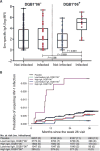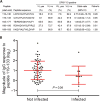HLA class II genes modulate vaccine-induced antibody responses to affect HIV-1 acquisition
- PMID: 26180102
- PMCID: PMC4911012
- DOI: 10.1126/scitranslmed.aab4005
HLA class II genes modulate vaccine-induced antibody responses to affect HIV-1 acquisition
Abstract
In the RV144 vaccine trial, two antibody responses were found to correlate with HIV-1 acquisition. Because human leukocyte antigen (HLA) class II-restricted CD4(+) T cells are involved in antibody production, we tested whether HLA class II genotypes affected HIV-1-specific antibody levels and HIV-1 acquisition in 760 individuals. Indeed, antibody responses correlated with acquisition only in the presence of single host HLA alleles. Envelope (Env)-specific immunoglobulin A (IgA) antibodies were associated with increased risk of acquisition specifically in individuals with DQB1*06. IgG antibody responses to Env amino acid positions 120 to 204 were higher and were associated with decreased risk of acquisition and increased vaccine efficacy only in the presence of DPB1*13. Screening IgG responses to overlapping peptides spanning Env 120-204 and viral sequence analysis of infected individuals defined differences in vaccine response that were associated with the presence of DPB1*13 and could be responsible for the protection observed. Overall, the underlying genetic findings indicate that HLA class II modulated the quantity, quality, and efficacy of antibody responses in the RV144 trial.
Copyright © 2015, American Association for the Advancement of Science.
Conflict of interest statement
Figures



References
-
- Rerks-Ngarm S, Pitisuttithum P, Nitayaphan S, Kaewkungwal J, Chiu J, Paris R, Premsri N, Namwat C, de Souza M, Adams E, Benenson M, Gurunathan S, Tartaglia J, McNeil JG, Francis DP, Stablein D, Birx DL, Chunsuttiwat S, Khamboonruang C, Thongcharoen P, Robb ML, Michael NL, Kunasol P, Kim JH. MOPH-TAVEG Investigators, Vaccination with ALVAC and AIDSVAX to prevent HIV-1 infection in Thailand. N Engl J Med. 2009;361:2209–2220. - PubMed
-
- Robb ML, Rerks-Ngarm S, Nitayaphan S, Pitisuttithum P, Kaewkungwal J, Kunasol P, Khamboonruang C, Thongcharoen P, Morgan P, Benenson M, Paris RM, Chiu J, Adams E, Francis D, Gurunathan S, Tartaglia J, Gilbert P, Stablein D, Michael NL, Kim JH. Risk behaviour and time as covariates for efficacy of the HIV vaccine regimen ALVAC-HIV (vCP1521) and AIDSVAX B/E: A post-hoc analysis of the Thai phase 3 efficacy trial RV 144. Lancet Infect Dis. 2012;12:531–537. - PMC - PubMed
-
- Haynes BF, Gilbert PB, McElrath MJ, Zolla-Pazner S, Tomaras GD, Alam SM, Evans DT, Montefiori DC, Karnasuta C, Sutthent R, Liao H-X, DeVico AL, Lewis GK, Williams C, Pinter A, Fong Y, Janes H, DeCamp A, Huang Y, Rao M, Billings E, Karasavvas N, Robb ML, Ngauy V, de Souza MS, Paris R, Ferrari G, Bailer RT, Soderberg KA, Andrews C, Berman PW, Frahm N, De Rosa SC, Alpert MD, Yates NL, Shen X, Koup RA, Pitisuttithum P, Kaewkungwal J, Nitayaphan S, Rerks-Ngarm S, Michael NL, Kim JH. Immune-correlates analysis of an HIV-1 vaccine efficacy trial. N Engl J Med. 2012;366:1275–1286. - PMC - PubMed
-
- Pinter A, Honnen WJ, Kayman SC, Trochev O, Wu Z. Potent neutralization of primary HIV-1 isolates by antibodies directed against epitopes present in the V1/V2 domain of HIV-1 gp120. Vaccine. 1998;16:1803–1811. - PubMed
-
- Kim JH, Excler J-L, Michael NL. Lessons from the RV144 Thai phase III HIV-1 vaccine trial and the search for correlates of protection. Annu Rev Med. 2015;66:423–437. - PubMed
Publication types
MeSH terms
Substances
Grants and funding
LinkOut - more resources
Full Text Sources
Other Literature Sources
Medical
Research Materials
Miscellaneous

